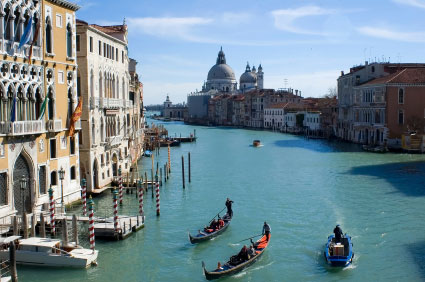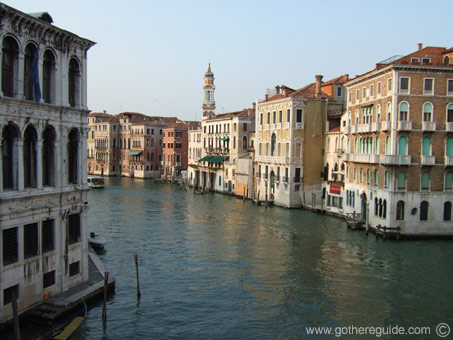
Grand Canal - Grand Canal information and pictures
| Tweet |
Some of the most remarkable buildings along the Grand Canal are: Santa Maria della Salute, Ca’ d’Oro, Accademia, Ca' Rezzonico, Palazzo Belloni Battagia, Palazzo Contarini del Bovolo, Ca’ Pesaro (houses a Gallery of Modern Art), Palazzo Sagredo, Palazzo Bembo, Palazzo Manin-Dolfin (1538), Ca’ Foscari (1437), Palazzo Garzoni, Palazzo Barbarigo, Palazzo Dario (1487), Palazzo Venier dei Leoni which houses the Peggy Guggenheim modern art collection.
Traditionally, the Grand Canal was an expensive residential area with large houses and luxury mansions. Wealthy residents settled here because of the easy access to shipping and transport. The Adriatic Veneti, the first inhabitants of the area, were fishermen and traders who lived in stilt houses. The lagoon became important under the Roman Empire, and the doge’s seat was moved to Rivoaltus. Fondaco houses were built, combining the merchant’s residence and the warehouse. During the Byzantine period, capitals, columns, friezes, and sculptures were shipped to decorate the houses of wealthy families. The Venetian-Byzantine style emerged from the fusion of Byzantine art and traditional elements. It is characterized by an abundance of polychrome marble, and ground level galleries with elongated or round arches.
Today, the Grand Canal is surrounded by mansions or palazzi, dating back to the 13th to 18th centuries. Among the many palaces are Palazzo Barbarigo, Palazzo Dario, and Palazzo Venier dei Leoni. Most buildings emerge from the water, and there is no pavement. Tourists can only see the fronts of the palaces. The eastern bank of the canal features mooring poles and balconies. There are a few canal-side sidewalks or fondamente, and the opportunities for taking pictures are rare.
The canal is lined by hotels, churches, mansions, and other buildings in the Renaissance, Gothic, and Romanesque styles. A few examples of earlier styles remain, but efforts are made to preserve some of the city’s famous palaces. The Ca' Barzizza is a 12th century mansion built in the Byzantine style. It is one of the few preserved buildings that date back to this period.
Many events are held along the Grand Canal such as the Historical Regatta and the Feast Day of the Madonna della Salute. Regata Storica is a traditional event, which was originally organized to honor persons of influence and celebrate military victories. Today, a competition between Venetian boats takes place along with the historical parade. The competition starts with a procession formed by bucintoro and bissone, followed by the boats of different rowing clubs. Regata Storica commemorates the coming of Caterina Cornaro, the Queen of Cyprus, an event that marked the beginning of the Serenissima Era. The historic parade has a symbolic importance and celebrates the former political and economic power of Venice. The followers and fans of each crew and boat crowd to watch the regatta and the parade. The city comes to life when the regatta ends, and people celebrate in boats of different sizes.
The Feast Day of the Madonna della Salute is held on November 21. Venetians come to thank Virgin Mary for saving their city from the 1629 – 1631 plague epidemic. Thousands of pilgrims cross Canale Grande on a pontoon bridge and enjoy traditional dishes and the stalls, offering sweets, balloons, toys, and snow-sugar.


Grand Canal, Venice, view from Rialto Bridge
Please help us build a better site. Add your comments about Grand Canal here.

Venice Attractions
Copyright © GoThereGuide.com 2015
All rights reserved.
All rights reserved.
User Comments about Grand Canal